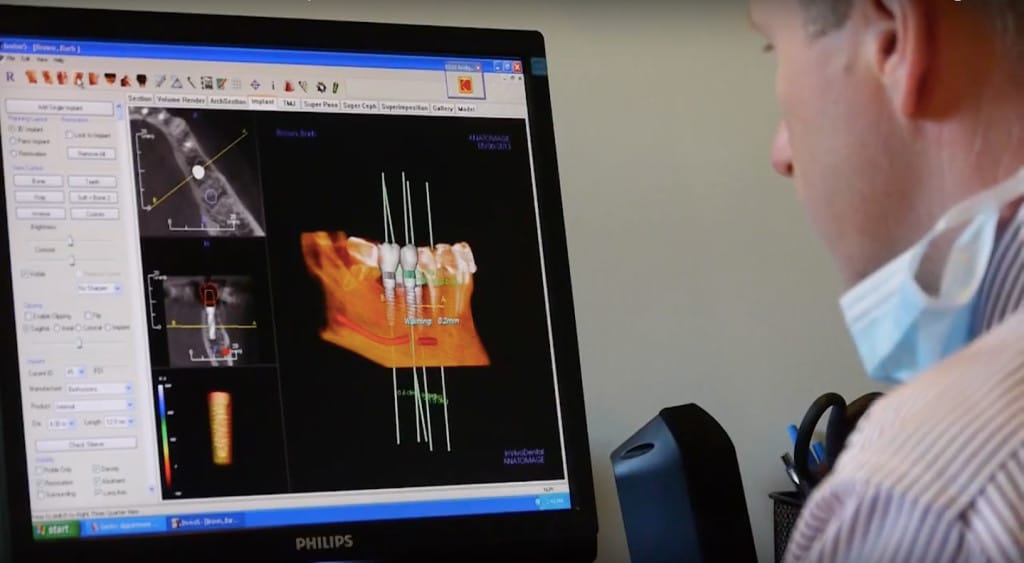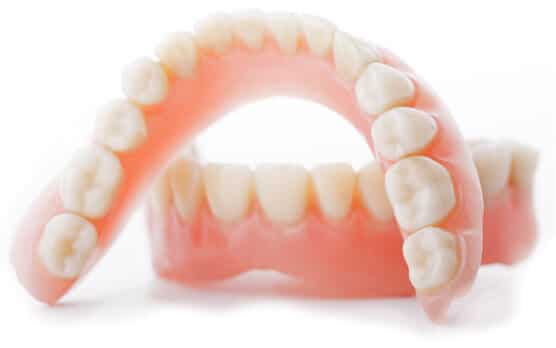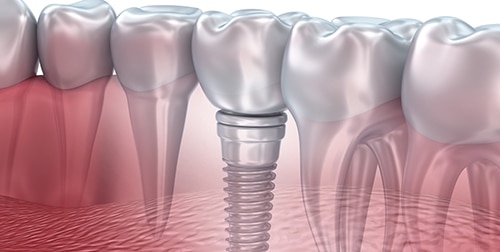Dental Implants Replace One Or ALL Of Your Teeth
Ready to talk about Dental Implants?
Enjoy the beauty of a healthy smile.
WHAT ARE DENTAL IMPLANTS?
Dental implants are artificial tooth roots inserted into the jaw to replace missing teeth. Today, dental implants attached with dental crowns are the preferred method for treating tooth loss because they function the same as natural teeth and help preserve the jaw structure by preventing atrophy from bone loss. Bridgework and traditional dentures address the cosmetic problem of missing teeth but do not prevent bone loss. Permanent dental implants (fixed dentures) maintain proper chewing function and exert appropriate, natural forces on the jawbone to keep it functional and healthy.
Implants are titanium screws a dentist inserts into the jawbone and affixes a prosthetic tooth or crown. Titanium implants over time fuse naturally with bone, a process known as osseointegration. Implant surgery can replace one or more teeth provided there is sufficient bone to support the implants. Would-be implant patients should have the procedure done as soon as possible after losing a tooth to prevent bone loss at the site.
3D IMAGES AND IMPLANT PLANNING SOFTWARE
Many dentists who provide dental implants now use 3D images and implant surgical planning software to construct a vivid map of the patient’s mouth, pinpoint potential problems, and plan the implant procedure in advance. During the initial visit, a 3D image is taken to enable the dentist to assess the bone structure and nerve locations, plan the surgery, and mold replacement teeth before the next visit.
From beginning to end, the process for dental implants could take three-to-nine months, but with 3D imaging, it’s possible to do single and full-mouth dental implants in far less time.
Implant dentists are concerned about both oral health and cosmetic outcomes. Replacing missing teeth helps regain a confident smile, as well as, staying fit and healthy by maintaining good nutritional habits and eating healthy foods your previous teeth were unable to chew.

TOOTH LOSS IS A MAJOR HEALTH PROBLEM BUT DENTURES AND BRIDGES AREN’T THE ANSWER
An estimated two in three Canadians have one or more missing teeth, mainly due to the rise in periodontal disease as the population grows older. Tooth loss and other oral health problems in older Americans recently prompted AARP to declare the “Over 50 Dental Crisis; In 2006, Dental Economics reported that more than 3 million Canadians are missing all their teeth in one or both jaws.

The AARP Bulletin warned that dental disease has become a silent epidemic among older Americans. Older adults with missing teeth often have underlying periodontal disease from which bacteria from a chronic gum infection can migrate through the bloodstream to vital organs. Adults with missing teeth are unable to eat properly and often develop nutritional deficiencies from an inadequate or unhealthy diet.
In addition to the dental and nutritional problems associated with missing teeth, there are social and personal self-esteem concerns as well. Missing teeth have a negative influence on personal self-confidence and social activities. Many family and social functions revolve around meals, and these situations can be difficult if not embarrassing for anyone who can’t chew properly. Also, spaces between missing teeth degenerate and can lead to significant bone loss that causes atrophy in the jawbone.
Some older adults with missing teeth rely on bridgework or dentures to preserve their dental function. Bridges require grinding down healthy teeth to function as abutments to anchor the side of the bridge without the crown. Over time, worn-out bridgework can be harmful for preserving dental function and preventing bone loss in the jaw. Bridges generally fail after 5-10 years as patients have difficulty flossing them. Therefore, root surfaces below and around bridgework become highly susceptible to decay and are not reparable. As a result, teeth supporting the old bridge often are lost, requiring insertion of longer bridges that further compromise dentition. For most patients, implants are a much better treatment alternative because they preserve the bone of the jaw, do not decay, and function just like natural teeth.
Removable dentures often are ill-fitting and usually too loose. In some cases, they don’t allow their wearers to eat and even talk properly. Many feel stigmatized, avoid social functions and feel inhibited from leading an active, healthy lifestyle. Scientific evidence supports that for patients who are edentulous in the lower jaw, implant-supported fixed prostheses are superior to removable dentures.
BONE AUGMENTATION
Implant dentists have become proficient at restoring or regenerating bone in tooth sockets that would not be able to support implant placements without augmentation. Sufficient bone mass is critical for implant surgery success. Digital imaging allows implant dentists to measure exact bone deficiency. Once the deficiency is determined from the image, the dentist can decide how much bone material will be needed for a successful implant.
The weight of several clinical studies has steered many implant dentists away from synthetic bone grafting material. Dental school research has generated strong evidence that using bone additives and growth factors achieve the best outcomes compared to synthetic bone, donor bone or harvesting outside the jaw.
Bone augmentation studies have provided solid evidence offering clinicians greater confidence for successful outcomes in bone-fortification procedures, which significantly impact the long-term success of dental implant treatment.
FOCUS ON EVIDENCE-BASED DENTISTRY
Today, implant dentists apply the principles of evidence-based dentistry in their practices. As implant dentistry grows in popularity, greater numbers of general dentists will add the specialty to their clinical services. Their success will depend on receiving high-quality training, such as the AAID credentialing program. Training focused on rigorous science from researchers and clinicians who have published widely enables new implant practitioners to adopt techniques and procedures that have been validated over time. Evidence-based research also holds great promise for developing streamlined protocols that will make implants affordable for greater numbers of prospective patients. To do this, implant dentists are adopting stricter controls and performance standards, especially when evaluating new products and technologies, to generate robust data in clinical studies to help find ways to further standardize dental implant protocols.








